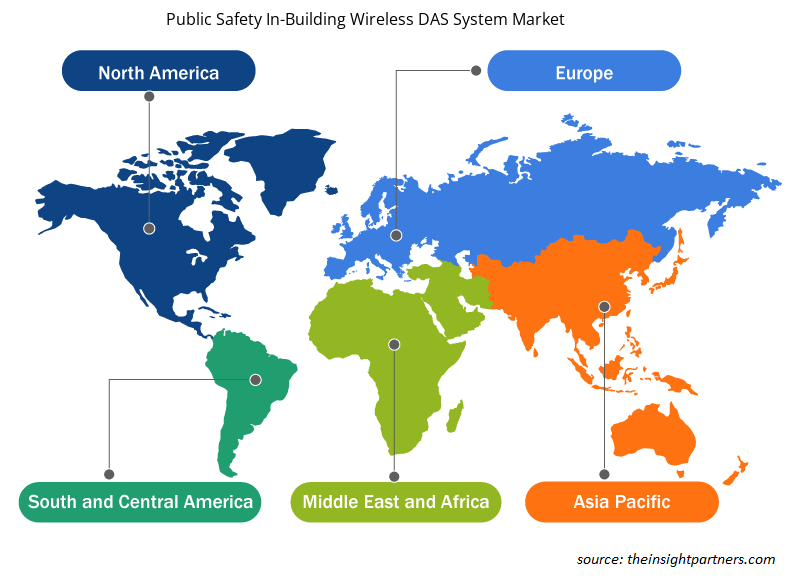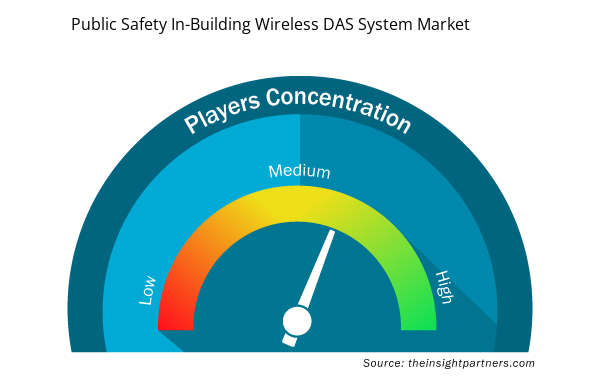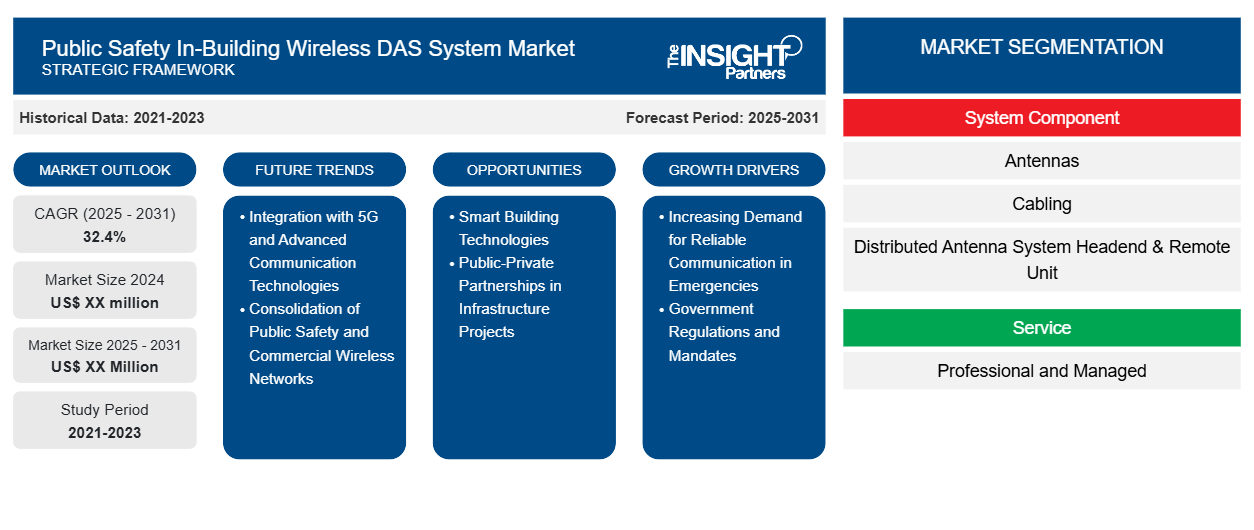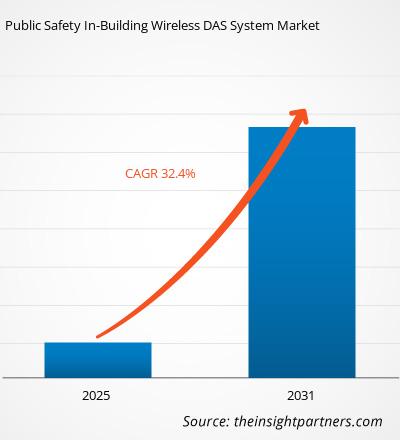Se espera que el mercado de sistemas DAS inalámbricos para seguridad pública en edificios registre una CAGR del 32,4 % entre 2024 y 2031, con un tamaño de mercado que se expandirá de US$ XX millones en 2024 a US$ XX millones en 2031.
El informe está segmentado por componente del sistema (antenas, cableado, cabecera y unidad remota del sistema de antena distribuida y repetidores); servicio (profesional y administrado) y aplicación (complejo de oficinas empresariales, complejo educativo, centros comerciales y complejos minoristas, complejo de atención médica, hotelería, complejo de transporte, complejo religioso y otros). El análisis global se desglosa aún más a nivel regional y por países principales. El informe ofrece el valor en USD para el análisis y los segmentos anteriores.
Propósito del Informe
El informe Public Safety In-Building Wireless DAS System Market de The Insight Partners tiene como objetivo describir el panorama actual y el crecimiento futuro, los principales factores impulsores, los desafíos y las oportunidades. Esto proporcionará información a diversas partes interesadas del negocio, como:
- Proveedores/fabricantes de tecnología: Para comprender la dinámica cambiante del mercado y conocer las oportunidades potenciales de crecimiento, lo que les permitirá tomar decisiones estratégicas informadas.
- Inversionistas: Realizar un análisis exhaustivo de tendencias sobre la tasa de crecimiento del mercado, las proyecciones financieras del mercado y las oportunidades que existen en toda la cadena de valor.
- Órganos reguladores: Regular las políticas y vigilar las actividades del mercado con el objetivo de minimizar los abusos, preservar la confianza de los inversores y defender la integridad y la estabilidad del mercado.
Segmentación del mercado de sistemas DAS inalámbricos para seguridad pública en edificios
Componente del sistema
- Antenas
- Cableado
- Unidad remota y cabecera del sistema de antena distribuida
- Repetidores
Servicio
- Profesional y Gestionado
Solicitud
- Complejo de oficinas empresariales
- Complejo Educativo
- Centros comerciales y complejos comerciales
- Complejo de salud
- Hospitalidad
- Complejo de transporte
- Complejo religioso
- Otros
Geografía
- América del norte
- Europa
- Asia-Pacífico
- América del Sur y Central
- Oriente Medio y África
Personalice este informe según sus necesidades
Obtendrá personalización en cualquier informe, sin cargo, incluidas partes de este informe o análisis a nivel de país, paquete de datos de Excel, así como también grandes ofertas y descuentos para empresas emergentes y universidades.
- Obtenga las principales tendencias clave del mercado de este informe.Esta muestra GRATUITA incluirá análisis de datos, desde tendencias del mercado hasta estimaciones y pronósticos.
Factores impulsores del crecimiento del mercado de sistemas DAS inalámbricos para seguridad pública en edificios
- Demanda creciente de comunicación confiable en situaciones de emergencia: los equipos de emergencia necesitan estar conectados en todo momento para coordinarse de manera eficaz durante un incendio, un desastre natural o una amenaza a la seguridad. Los sistemas DAS ofrecen comunicación inalámbrica confiable en el interior de los edificios, incluso en regiones con materiales como el hormigón o el acero que pueden bloquear las señales.
- Normas y mandatos gubernamentales: En muchos países, se han aplicado normas que obligan a los propietarios de edificios a instalar sistemas inalámbricos en sus edificios para garantizar que se cumplan los requisitos de unas comunicaciones de seguridad pública eficaces. Por ejemplo, la FCC de los EE. UU. ha establecido requisitos mínimos de intensidad de señal para las redes de seguridad pública, lo que ha obligado a los propietarios y promotores a diseñar nuevas construcciones o a modernizar los edificios existentes con sistemas DAS.
Tendencias futuras del mercado de sistemas DAS inalámbricos para seguridad pública en edificios
- Integración con 5G y tecnologías de comunicación avanzadas: a medida que se expande la implementación de redes 5G, los sistemas DAS en edificios deben soportar velocidades más altas y una latencia más baja. El beneficio directo de la tecnología 5G es que puede garantizar la transferencia en tiempo real de grandes volúmenes de datos, lo que ayuda con el trabajo de videovigilancia, las operaciones con drones, los diagnósticos médicos remotos y muchas otras tareas. Los proveedores de DAS están creando sistemas para preparar los edificios para la comunicación de próxima generación.
- Consolidación de las redes inalámbricas comerciales y de seguridad pública: se observan avances en la integración de las redes de seguridad pública con las redes celulares comerciales. Los sistemas DAS de seguridad pública, que antes existían de forma aislada, ahora comparten cada vez más infraestructuras con las redes comerciales. Esta confluencia da como resultado soluciones rentables y un uso eficiente de los recursos mediante el uso compartido de las redes celulares existentes para los servicios de seguridad pública y los servicios comerciales.
Oportunidades de mercado para sistemas DAS inalámbricos de seguridad pública en edificios
- Tecnologías de edificios inteligentes: con la llegada de los edificios inteligentes y la integración de dispositivos IoT, las soluciones DAS pueden interactuar con otros sistemas de gestión de edificios, como sistemas de seguridad inteligentes, alarmas contra incendios y sistemas HVAC. Esto ayuda a mejorar la seguridad, la eficiencia y las capacidades de respuesta rápida de los edificios, lo que representa una oportunidad para que las empresas crezcan en el mercado combinado de soluciones DAS e IoT.
- Asociaciones público-privadas en proyectos de infraestructura: los gobiernos están promoviendo asociaciones público-privadas para el desarrollo de infraestructura, incluida la instalación de sistemas de comunicación de seguridad pública. Estas asociaciones ofrecen a los proveedores de DAS una oportunidad potencial de colaborar con agencias gubernamentales para instalar infraestructuras de comunicación sólidas en edificios públicos nuevos o renovados en diversos sectores, incluidos el transporte, la atención médica y la educación.
Perspectivas regionales del mercado de sistemas DAS inalámbricos para seguridad pública en edificios
Los analistas de Insight Partners explicaron en detalle las tendencias y los factores regionales que influyen en el mercado de sistemas DAS inalámbricos para interiores de seguridad pública durante el período de pronóstico. Esta sección también analiza los segmentos y la geografía del mercado de sistemas DAS inalámbricos para interiores de seguridad pública en América del Norte, Europa, Asia Pacífico, Oriente Medio y África, y América del Sur y Central.

- Obtenga datos regionales específicos para el mercado de sistemas DAS inalámbricos para interiores y de seguridad pública
Alcance del informe de mercado de sistemas DAS inalámbricos para seguridad pública en edificios
| Atributo del informe | Detalles |
|---|---|
| Tamaño del mercado en 2024 | XX millones de dólares estadounidenses |
| Tamaño del mercado en 2031 | US$ XX millones |
| Tasa de crecimiento anual compuesta (CAGR) global (2025-2031) | 32,4% |
| Datos históricos | 2021-2023 |
| Período de pronóstico | 2025-2031 |
| Segmentos cubiertos | Por componente del sistema
|
| Regiones y países cubiertos | América del norte
|
| Líderes del mercado y perfiles de empresas clave |
|
Densidad de actores del mercado de sistemas DAS inalámbricos para seguridad pública en edificios: comprensión de su impacto en la dinámica empresarial
El mercado de sistemas DAS inalámbricos para interiores de seguridad pública está creciendo rápidamente, impulsado por la creciente demanda de los usuarios finales debido a factores como la evolución de las preferencias de los consumidores, los avances tecnológicos y una mayor conciencia de los beneficios del producto. A medida que aumenta la demanda, las empresas amplían sus ofertas, innovan para satisfacer las necesidades de los consumidores y aprovechan las tendencias emergentes, lo que impulsa aún más el crecimiento del mercado.
La densidad de actores del mercado se refiere a la distribución de las empresas o firmas que operan dentro de un mercado o industria en particular. Indica cuántos competidores (actores del mercado) están presentes en un espacio de mercado determinado en relación con su tamaño o valor total de mercado.
Las principales empresas que operan en el mercado de sistemas DAS inalámbricos para seguridad pública en edificios son:
- Comunicaciones de Verizon Inc.
- Ericsson
- Alcatel-Lucent SA
- Compañía: AT&T Inc.
- Compañía: Commscope Inc.
Descargo de responsabilidad : Las empresas enumeradas anteriormente no están clasificadas en ningún orden particular.

- Obtenga una descripción general de los principales actores clave del mercado de sistemas DAS inalámbricos para seguridad pública en edificios
Puntos de venta clave
- Cobertura integral: el informe cubre de manera integral el análisis de productos, servicios, tipos y usuarios finales del mercado de sistemas DAS inalámbricos para seguridad pública en edificios, proporcionando un panorama holístico.
- Análisis de expertos: el informe se compila sobre la base de un profundo conocimiento de expertos y analistas de la industria.
- Información actualizada: El informe asegura relevancia comercial debido a su cobertura de información reciente y tendencias de datos.
- Opciones de personalización: este informe se puede personalizar para satisfacer los requisitos específicos del cliente y adaptarse adecuadamente a las estrategias comerciales.
Por lo tanto, el informe de investigación sobre el mercado de sistemas DAS inalámbricos para interiores de seguridad pública puede ayudar a abrir camino para descifrar y comprender el escenario de la industria y las perspectivas de crecimiento. Si bien puede haber algunas preocupaciones válidas, los beneficios generales de este informe tienden a superar las desventajas.
- Análisis histórico (2 años), año base, pronóstico (7 años) con CAGR
- Análisis PEST y FODA
- Tamaño del mercado Valor/volumen: global, regional, nacional
- Industria y panorama competitivo
- Conjunto de datos de Excel



Report Coverage
Revenue forecast, Company Analysis, Industry landscape, Growth factors, and Trends

Segment Covered
This text is related
to segments covered.

Regional Scope
North America, Europe, Asia Pacific, Middle East & Africa, South & Central America

Country Scope
This text is related
to country scope.
Preguntas frecuentes
Some of the customization options available based on the request are an additional 3-5 company profiles and country-specific analysis of 3-5 countries of your choice. Customizations are to be requested/discussed before making final order confirmation# as our team would review the same and check the feasibility
The report can be delivered in PDF/PPT format; we can also share excel dataset based on the request
Integration with 5G and advanced communication technologies; and consolidation of public safety and commercial wireless networks are likely to remain a key trend in the market.
Increasing demand for reliable communication in emergencies and government regulations and mandates are the major factors driving the public safety in-building wireless DAS system market.
The Public Safety In-Building Wireless DAS System Market is estimated to witness a CAGR of 32.4% from 2023 to 2031
Trends and growth analysis reports related to Electronics and Semiconductor : READ MORE..
The List of Companies
1. Verizon Communications Inc.
2. Ericsson
3. Alcatel-Lucent SA
4. AT&T Inc.
5. Commscope Inc.
6. Anixter Inc.
7. Cobham PLC
8. Corning Inc.
9. Smiths Group PLC
10. TE Connectivity Ltd.
The Insight Partners performs research in 4 major stages: Data Collection & Secondary Research, Primary Research, Data Analysis and Data Triangulation & Final Review.
- Data Collection and Secondary Research:
As a market research and consulting firm operating from a decade, we have published and advised several client across the globe. First step for any study will start with an assessment of currently available data and insights from existing reports. Further, historical and current market information is collected from Investor Presentations, Annual Reports, SEC Filings, etc., and other information related to company’s performance and market positioning are gathered from Paid Databases (Factiva, Hoovers, and Reuters) and various other publications available in public domain.
Several associations trade associates, technical forums, institutes, societies and organization are accessed to gain technical as well as market related insights through their publications such as research papers, blogs and press releases related to the studies are referred to get cues about the market. Further, white papers, journals, magazines, and other news articles published in last 3 years are scrutinized and analyzed to understand the current market trends.
- Primary Research:
The primarily interview analysis comprise of data obtained from industry participants interview and answers to survey questions gathered by in-house primary team.
For primary research, interviews are conducted with industry experts/CEOs/Marketing Managers/VPs/Subject Matter Experts from both demand and supply side to get a 360-degree view of the market. The primary team conducts several interviews based on the complexity of the markets to understand the various market trends and dynamics which makes research more credible and precise.
A typical research interview fulfils the following functions:
- Provides first-hand information on the market size, market trends, growth trends, competitive landscape, and outlook
- Validates and strengthens in-house secondary research findings
- Develops the analysis team’s expertise and market understanding
Primary research involves email interactions and telephone interviews for each market, category, segment, and sub-segment across geographies. The participants who typically take part in such a process include, but are not limited to:
- Industry participants: VPs, business development managers, market intelligence managers and national sales managers
- Outside experts: Valuation experts, research analysts and key opinion leaders specializing in the electronics and semiconductor industry.
Below is the breakup of our primary respondents by company, designation, and region:

Once we receive the confirmation from primary research sources or primary respondents, we finalize the base year market estimation and forecast the data as per the macroeconomic and microeconomic factors assessed during data collection.
- Data Analysis:
Once data is validated through both secondary as well as primary respondents, we finalize the market estimations by hypothesis formulation and factor analysis at regional and country level.
- Macro-Economic Factor Analysis:
We analyse macroeconomic indicators such the gross domestic product (GDP), increase in the demand for goods and services across industries, technological advancement, regional economic growth, governmental policies, the influence of COVID-19, PEST analysis, and other aspects. This analysis aids in setting benchmarks for various nations/regions and approximating market splits. Additionally, the general trend of the aforementioned components aid in determining the market's development possibilities.
- Country Level Data:
Various factors that are especially aligned to the country are taken into account to determine the market size for a certain area and country, including the presence of vendors, such as headquarters and offices, the country's GDP, demand patterns, and industry growth. To comprehend the market dynamics for the nation, a number of growth variables, inhibitors, application areas, and current market trends are researched. The aforementioned elements aid in determining the country's overall market's growth potential.
- Company Profile:
The “Table of Contents” is formulated by listing and analyzing more than 25 - 30 companies operating in the market ecosystem across geographies. However, we profile only 10 companies as a standard practice in our syndicate reports. These 10 companies comprise leading, emerging, and regional players. Nonetheless, our analysis is not restricted to the 10 listed companies, we also analyze other companies present in the market to develop a holistic view and understand the prevailing trends. The “Company Profiles” section in the report covers key facts, business description, products & services, financial information, SWOT analysis, and key developments. The financial information presented is extracted from the annual reports and official documents of the publicly listed companies. Upon collecting the information for the sections of respective companies, we verify them via various primary sources and then compile the data in respective company profiles. The company level information helps us in deriving the base number as well as in forecasting the market size.
- Developing Base Number:
Aggregation of sales statistics (2020-2022) and macro-economic factor, and other secondary and primary research insights are utilized to arrive at base number and related market shares for 2022. The data gaps are identified in this step and relevant market data is analyzed, collected from paid primary interviews or databases. On finalizing the base year market size, forecasts are developed on the basis of macro-economic, industry and market growth factors and company level analysis.
- Data Triangulation and Final Review:
The market findings and base year market size calculations are validated from supply as well as demand side. Demand side validations are based on macro-economic factor analysis and benchmarks for respective regions and countries. In case of supply side validations, revenues of major companies are estimated (in case not available) based on industry benchmark, approximate number of employees, product portfolio, and primary interviews revenues are gathered. Further revenue from target product/service segment is assessed to avoid overshooting of market statistics. In case of heavy deviations between supply and demand side values, all thes steps are repeated to achieve synchronization.
We follow an iterative model, wherein we share our research findings with Subject Matter Experts (SME’s) and Key Opinion Leaders (KOLs) until consensus view of the market is not formulated – this model negates any drastic deviation in the opinions of experts. Only validated and universally acceptable research findings are quoted in our reports.
We have important check points that we use to validate our research findings – which we call – data triangulation, where we validate the information, we generate from secondary sources with primary interviews and then we re-validate with our internal data bases and Subject matter experts. This comprehensive model enables us to deliver high quality, reliable data in shortest possible time.


 Obtenga una muestra gratuita de este informe
Obtenga una muestra gratuita de este informe